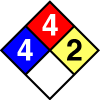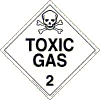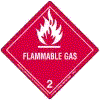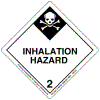Phosphine: Lung Damaging Agent
CAS #:
7803-51-2
RTECS #: SY7525000
UN #: 2199 (Guide 119)
Common Names:
- Hydrogen phosphide
- Phosphorus hydride
- Phosphorus trihydride
Agent Characteristics
Colorless gas.
Phosphine is used in the semiconductor industry to introduce phosphorus into silicon crystals . It is also used as a fumigant, a polymerization initiator and as an intermediate for the preparation of several flame retardants. Phosphine has an odor of garlic or decaying fish but is odorless when pure. The level at which humans detect the odor of phosphine (odor threshold) does not provide sufficient warning of dangerous concentrations. It is shipped as liquefied compressed gas. Several solids (phosphides) release phosphine gas. When phosphine toxicity is suspected, but phosphine exposure has not occurred, ingestion or transdermal contamination from phosphides should be considered.
- Indoor Air: Phosphine can be released into indoor air as a gas.
- Water: Phosphine breaks down in water and cannot be used to contaminate water supplies.
- Food: Phosphine cannot contaminate food.
- Outdoor Air: Phosphine can be released into outdoor air as a gas.
- Agricultural: If phosphine is released as a gas, it is highly unlikely to contaminate agricultural products.
Phosphine can be absorbed into the body by inhalation. Direct contact with phosphine liquid may cause frostbite.
Personal Protective Equipment
First Responders should use a NIOSH-certified Chemical, Biological, Radiological, Nuclear (CBRN) Self Contained Breathing Apparatus (SCBA) with a Level A protective suit when entering an area with an unknown contaminant or when entering an area where the concentration of the contaminant is unknown. Level A protection should be used until monitoring results confirm the contaminant and the concentration of the contaminant.
NOTE: Safe use of protective clothing and equipment requires specific skills developed through training and experience.
Select when the greatest level of skin, respiratory, and eye protection is required. This is the maximum protection for workers in danger of exposure to unknown chemical hazards or levels above the IDLH or greater than the AEGL-2.
- A NIOSH-certified CBRN full-face-piece SCBA operated in a pressure-demand mode or a pressure-demand supplied air hose respirator with an auxiliary escape bottle.
- A Totally-Encapsulating Chemical Protective (TECP) suit that provides protection against CBRN agents.
- Chemical-resistant gloves (outer).
- Chemical-resistant gloves (inner).
- Chemical-resistant boots with a steel toe and shank.
- Coveralls, long underwear, and a hard hat worn under the TECP suit are optional items.
Select when the highest level of respiratory protection is necessary but a lesser level of skin protection is required. This is the minimum protection for workers in danger of exposure to unknown chemical hazards or levels above the IDLH or greater than AEGL-2. It differs from Level A in that it incorporates a non-encapsulating, splash-protective, chemical-resistant splash suit that provides Level A protection against liquids but is not airtight.
- A NIOSH-certified CBRN full-face-piece SCBA operated in a pressure-demand mode or a pressure-demand supplied air hose respirator with an auxiliary escape bottle.
- A hooded chemical-resistant suit that provides protection against CBRN agents.
- Chemical-resistant gloves (outer).
- Chemical-resistant gloves (inner).
- Chemical-resistant boots with a steel toe and shank.
- Coveralls, long underwear, a hard hat worn under the chemical-resistant suit, and chemical-resistant disposable boot-covers worn over the chemical-resistant suit are optional items.
Select when the contaminant and concentration of the contaminant are known and the respiratory protection criteria factors for using Air Purifying Respirators (APR) or Powered Air Purifying Respirators (PAPR) are met. This level is appropriate when decontaminating patient/victims.
- A NIOSH-certified CBRN tight-fitting APR with a canister-type gas mask or CBRN PAPR for air levels greater than AEGL-2.
- A NIOSH-certified CBRN PAPR with a loose-fitting face-piece, hood, or helmet and a filter or a combination organic vapor, acid gas, and particulate cartridge/filter combination or a continuous flow respirator for air levels greater than AEGL-1.
- A hooded chemical-resistant suit that provides protection against CBRN agents.
- Chemical-resistant gloves (outer).
- Chemical-resistant gloves (inner).
- Chemical-resistant boots with a steel toe and shank.
- Escape mask, face shield, coveralls, long underwear, a hard hat worn under the chemical-resistant suit, and chemical-resistant disposable boot-covers worn over the chemical-resistant suit are optional items.
Select when the contaminant and concentration of the contaminant are known and the concentration is below the appropriate occupational exposure limit or less than AEGL-1 for the stated duration times.
- Limited to coveralls or other work clothes, boots, and gloves.
Emergency Response
- Phosphine decomposes on heating or on burning, producing toxic fumes.
- Phosphine reacts with acids, air, copper, moisture, and oxidants.
- Phosphine is extremely explosive.
- The agent may form explosive mixtures with air.
- Run-off may create an explosion hazard.
- Containers may explode when heated.
- Ruptured cylinders may rocket.
- Lower explosive (flammable) limit in air (LEL), 1.79%; upper explosive (flammable) limit in air (UEL), unknown.
- Phosphine is extremely flammable and explosive.
- The agent may ignite spontaneously on contact with air.
- The agent may be ignited by heat, sparks, or flames.
- When phosphine burns, it produces a dense white cloud of a severe respiratory irritant (phosphorus pentoxide).
- Vapors may travel to the source of ignition and flash back.
- Run-off may create a fire hazard.
- Do not extinguish a leaking gas fire unless the leak can be stopped.
- For small fires, use dry chemical, carbon dioxide, water spray, or alcohol-resistant foam.
- For large fires, use water spray, fog, or alcohol-resistant foam. Move containers from the fire area if it is possible to do so without risk to personnel. Damaged cylinders should be handled only by specialists.
- For fire involving tanks, fight the fire from maximum distance or use unmanned hose holders or monitor nozzles. Cool containers with flooding quantities of water until well after the fire is out. Do not direct water at the source of the leak or at safety devices; icing may occur. Withdraw immediately in case of rising sound from venting safety devices or discoloration of tanks. Always stay away from tanks engulfed in fire.
- Run-off from fire control may cause pollution.
- If the situation allows, control and properly dispose of run-off (effluent).
- If a tank, rail car, or tank truck is involved in a fire, isolate it for 1 mi (1600 m) in all directions; also consider initial evacuation for 1 mi (1600 m) in all directions.
- Small spills
- First isolate in all directions: 200 ft (60 m).
- Then protect persons downwind during the day: 0.4 mi (0.7 km).
- Then protect persons downwind during the night: 1.9 mi (3.1 km).
- Large spills
- First isolate in all directions: 1400 ft (450 m).
- Then protect persons downwind during the day: 2.7 mi (4.3 km).
- Then protect persons downwind during the night: 6.0 mi (9.6 km).
- Vapors are heavier than air. They will spread along the ground and collect and stay in poorly-ventilated, low-lying, or confined areas (e.g., sewers, basements, and tanks).
- Hazardous concentrations may develop quickly in enclosed, poorly-ventilated, or low-lying areas. Keep out of these areas. Stay upwind.
- Health: 4
- Flammability: 4
- Reactivity: 2
- Special:

- OSHA: 1003, ID 180
- NIOSH: Not established/determined
- AIR MATRIX
NIOSH [1994]. Phosphine: Method 6002. In: NIOSH Manual of Analytical Methods. 4th ed. Cincinnati, OH: U.S. Department for Health and Human Services, Public Health Service, Centers for Disease Control and Prevention, National Institute for Occupational Safety and Health, DHHS (NIOSH) Publication No. 94-113.OSHA [1991]. Phosphine in workplace atmospheres: OSHA-SLTC Method ID-180. Salt Lake City, UT: U.S. Department of Labor, Occupational Safety and Health Administration.OSHA [2000]. Phosphine: OSHA-SLTC Method 1003. Salt Lake City, UT: U.S. Department of Labor, Occupational Safety and Health Administration.Pavageau MP, Pécheyran C, Demange M, Donard FX [2003]. Phosphine emission measurements from a tobacco factory using cryogenic sampling and GC-ICP-MS analysis. J Anal Atom Spectrom 18(4):323-329.
Varfolomeev AE, Volkov AI, Eryshkin AV, Malyshev VV, Rasumov AS, Yakimov SS [1992]. Detection of phosphine and arsine in air by sensors based on SnO2 and ZnO. Sensors and Actuators B: Chem 7(1-3):727-729. Abstract.
- OTHER
No references were identified for this sampling matrix for this agent. - SOIL MATRIX
Roels J, Langenhove HV, Verstraete W. Determination of phosphine in biogas and sludge at ppt-levels with gas chromatography-thermionic specific detection. J Chromatogr A 952(1-2):229-237. - SURFACES
No references were identified for this sampling matrix for this agent. - WATER
No references were identified for this sampling matrix for this agent.
Signs/Symptoms
Adverse health effects generally occur within the first few hours following inhalation of phosphine. Cardiovascular complications may cause death within 12 to 24 hours following exposure. Signs of liver damage may be delayed 48 to 72 hours following exposure. Deaths that occur 24 hours after exposure are usually a result of liver or kidney failure. Fluid in the lungs (pulmonary edema) may be delayed for 72 hours following exposure.
Phosphine inhibits the body’s ability to produce proteins. Adverse health effects from phosphine exposure are dose dependent. Inhaling phosphine causes respiratory irritation, compromises heart (cardiac) and circulatory functions, depresses the central nervous system, and produces severe gastrointestinal pain.
- Phosphine gas produces no known adverse effects on the eyes.
- Ocular exposure to phosphine gas has not been known to cause systemic toxicity.
- Direct eye contact with liquefied or compressed phosphine gas, which is unlikely, may cause frostbite.
- Phosphine is present as a gas at room temperature, so ingestion is unlikely.
- See Inhalation Exposure.
- Mild to moderate: Severe lung irritation; chest tightness or burning chest pain; cough, sometimes productive of fluorescent green sputum; difficulty breathing or shortness of breath (dyspnea); and accumulation of fluid in the lungs (pulmonary edema). Cardiovascular effects include abnormally low blood pressure (hypotension), irregular heart rhythm (dysrhythmia), and decreased ability of the heart to pump a normal blood volume. Nervous system effects include headache, restlessness, irritability, dizziness, lethargy, drowsiness, fatigue, loss of feeling, impaired gait, trembling of the extremities during movement, and double vision. Gastrointestinal effects include nausea, vomiting (emesis), diarrhea, abdominal pain, gastrointestinal distress, and liver injury. General effects include sweating and bluish discoloration of the skin (cyanosis).
- Severe: Death. Lung effects include accumulation of fluid in the lungs (pulmonary edema). Cardiovascular effects include abnormally low blood pressure (hypotension); abnormally rapid heart rate (tachycardia); collapse of blood vessels (peripheral vascular collapse) not responsive to drug therapy; abnormal, life-threatening heart rhythms (ventricular dysrhythmias); cardiac arrest; and critically low blood pressure (shock). Nervous system effects include seizures and prolonged loss of consciousness (coma).
- Phosphine gas is not known to produce adverse effects on the skin.
- Contact with the skin does not normally result in whole-body (systemic) toxicity.
- Skin contact with liquefied or compressed phosphine gas may cause frostbite.
Decontamination
The purpose of decontamination is to make an individual and/or their equipment safe by physically removing toxic substances quickly and effectively. Care should be taken during decontamination, because absorbed agent can be released from clothing and skin as a gas. Your Incident Commander will provide you with decontaminants specific for the agent released or the agent believed to have been released.
The following are recommendations to protect the first responders from the release area:
- Position the decontamination corridor upwind and uphill of the hot zone. The warm zone should include two decontamination corridors. One decontamination corridor is used to enter the warm zone and the other for exiting the warm zone into the cold zone. The decontamination zone for exiting should be upwind and uphill from the zone used to enter.
- Decontamination area workers should wear appropriate PPE. See the PPE section of this card for detailed information.
- A solution of detergent and water (which should have a pH value of at least 8 but should not exceed a pH value of 10.5) should be available for use in decontamination procedures. Soft brushes should be available to remove contamination from the PPE. Labeled, durable 6-mil polyethylene bags should be available for disposal of contaminated PPE.
The following methods can be used to decontaminate an individual:
- Decontamination of First Responder:
- Begin washing PPE of the first responder using soap and water solution and a soft brush. Always move in a downward motion (from head to toe). Make sure to get into all areas, especially folds in the clothing. Wash and rinse (using cold or warm water) until the contaminant is thoroughly removed.
- Remove PPE by rolling downward (from head to toe) and avoid pulling PPE off over the head. Remove the SCBA after other PPE has been removed.
- Place all PPE in labeled durable 6-mil polyethylene bags.
- Decontamination of Patient/Victim:
- Remove the patient/victim from the contaminated area and into the decontamination corridor.
- Remove all clothing (at least down to their undergarments) and place the clothing in a labeled durable 6-mil polyethylene bag.
- Thoroughly wash and rinse (using cold or warm water) the contaminated skin of the patient/victim using a soap and water solution. Be careful not to break the patient/victim’s skin during the decontamination process, and cover all open wounds.
- Cover the patient/victim to prevent shock and loss of body heat.
- Move the patient/victim to an area where emergency medical treatment can be provided.
First Aid
Initial treatment is primarily supportive.
There is no antidote for phosphine toxicity.
- Immediately remove the patient/victim from the source of exposure.
- Immediately wash eyes with large amounts of tepid water for at least 15 minutes.
- If frostbite occurs from contact with liquid (compressed) phosphine, thaw with lukewarm water.
- Seek medical attention immediately.
- Immediately remove the patient/victim from the source of exposure.
- Ensure that the patient/victim has an unobstructed airway.
- Do not induce vomiting (emesis).
- See the Inhalation section for first aid recommendations.
- Seek medical attention immediately.
- Immediately remove the patient/victim from the source of exposure.
- Evaluate respiratory function and pulse.
- Ensure that the patient/victim has an unobstructed airway.
- If shortness of breath occurs or breathing is difficult (dyspnea), administer oxygen.
- Assist ventilation as required. Always use a barrier or bag-valve-mask device.
- If breathing has ceased (apnea), provide artificial respiration.
- Monitor for respiratory distress.
- Establish intravenous (IV) access if necessary.
- Place the patient/victim on a cardiac monitor.
- Monitor heart function, and evaluate for low blood pressure (hypotension), abnormal heart rhythms (dysrhythmias), and reduced respiratory function (respiratory depression).
- In cases of respiratory compromise, secure the airway and respiration by inserting a tube within the trachea (endotracheal intubation).
- If evidence of shock or low blood pressure (hypotension) is observed, begin intravenous (IV) fluid administration.
- If seizures occur, treat with benzodiazepines.
- Seek medical attention immediately.
- Immediately remove the patient/victim from the source of exposure.
- See the Decontamination section for patient/victim decontamination procedures.
- In cases of contact with liquid agent (compressed gas), thaw frostbitten skin with lukewarm water; gently remove clothing from the affected area. Dry with clean towels and keep the victim warm and quiet.
- Seek medical attention immediately.
Long-Term Implications
Patient/victims should be monitored and evaluated for heart, liver, kidney, and lung damage. Lung damage, which may be delayed, typically presents as a build-up of fluid in the lungs (pulmonary edema). If the patient/victim survives the initial 24 hours, heart damage is typically reversible. Patient/victims should also be evaluated for low blood sugar (hypoglycemia), electrolyte disturbances, and diminished oxygen supply to the tissues (hypoxia). Deaths after 24 hours are usually due to liver or kidney failure.
Although most survivors of acute phosphine exposure show no permanent disabilities, damage due to insufficient blood supply to the heart and brain has been reported. Subacute poisoning resulting from exposure for a few days may cause reactive airways dysfunction syndrome (RADS) months later. Yellowish pigmentation of the skin and tissues (jaundice) caused by liver damage, presence of excess protein in the urine (proteinuria), acute kidney failure, abnormal blood magnesium (hypo- or hypermagnesemia), and low blood levels of potassium (hypokalemia) may occur.
Although phosphine is not classifiable as a carcinogen, or as capable of causing developmental or reproductive toxicity, chronic exposure to this agent has been associated with chromosomal damage. Chronic exposure to very low concentrations may result in low red blood cell counts (anemia), inflammation of the large airways (bronchitis), gastrointestinal disturbances, kidney failure, and visual, speech, and motor disturbances. These adverse health effects may be more of a concern for children than for adults with similar levels of exposure. Toothache, jaw swelling, and spontaneous fractures of the bones (phossy jaw), are also results of chronic phosphine exposure.
On-Site Fatalities
- Consult with the Incident Commander regarding the agent dispersed, dissemination method, level of PPE required, location, geographic complications (if any), and the approximate number of remains.
- Coordinate responsibilities and prepare to enter the scene as part of the evaluation team along with the FBI HazMat Technician, local law enforcement evidence technician, and other relevant personnel.
- Begin tracking remains using waterproof tags.
- Wear PPE until all remains are deemed free of contamination.
- Establish a preliminary (holding) morgue.
- Gather evidence, and place it in a clearly labeled impervious container. Hand any evidence over to the FBI.
- Remove and tag personal effects.
- Perform a thorough external evaluation and a preliminary identification check.
- See the Decontamination section for decontamination procedures.
- Decontaminate remains before they are removed from the incident site.
Occupational Exposure Limits
- NIOSH REL:
- TWA (10-hour): 0.3 ppm (0.4 mg/m3)
- STEL (15-minute): 1 ppm (1 mg/m3)
- OSHA PEL:
- TWA (8-hour): 0.3 ppm (0.4 mg/m3)
- ACGIH TLV:
- TWA (8-hour): 0.3 ppm
- STEL (15-minute): 1 ppm
- NIOSH IDLH: 50 ppm
- DOE TEEL:
- TEEL-0: 0.4 mg/m3
- TEEL-1: 1.25 mg/m3
- TEEL-2: 2.78 mg/m3
- TEEL-3: 5 mg/m3
- AIHA ERPG:
- ERPG-1: Not appropriate.
- ERPG-2: 0.5 ppm
- ERPG-3: 5 ppm
Acute Exposure Guidelines
| 10 min | 30 min | 60 min | 4 hr | 8 hr | |
|---|---|---|---|---|---|
| AEGL 1 (discomfort, non-disabling) – ppm |
NR | NR | NR | NR | NR |
| AEGL 2 (irreversible or other serious, long-lasting effects or impaired ability to escape) – ppm |
4.0 ppm | 4.0 ppm | 2.0 ppm | 0.50 ppm | 0.25 ppm |
| AEGL 3 (life-threatening effects or death) – ppm |
7.2 ppm | 7.2 ppm | 3.6 ppm | 0.90 ppm | 0.45 ppm |
NR = Not recommended due to insufficient data
Decontamination (Environment and Equipment)
The following methods can be used to decontaminate the environment/spillage disposal:
- Do not touch or walk through the spilled agent if at all possible. However, if you must, personnel should wear the appropriate PPE during environmental decontamination. See the PPE section of this card for detailed information.
- Keep combustibles (e.g., wood, paper, and oil) away from the spilled agent. Use water spray to reduce vapors or divert vapor cloud drift. Avoid allowing water runoff to contact the spilled agent.
- Do not direct water at the spill or the source of the leak.
- Stop the leak if it is possible to do so without risk to personnel, and turn leaking containers so that gas rather than liquid escapes.
- Prevent entry into waterways, sewers, basements, or confined areas.
- Isolate the area until gas has dispersed.
- Ventilate the area.
Agents can seep into the crevices of equipment making it dangerous to handle. The following methods can be used to decontaminate equipment:
- Not established/determined
Agent Properties
- Chemical Formula:
PH3 - Aqueous solubility:
Soluble - Boiling Point:
-126°F (-87.7°C) - Density:
Gas: 1.17 - Flammability:
Extremely flammable - Flashpoint:
220°F (104.4°C)
- Ionization potential:
9.96 eV
- Log Kbenzene-water:
Not established/determined - Log Kow (estimated):
-0.27 - Melting Point:
-207°F (-133°C) - Molecular Mass:
34.00
- Soluble In:
Alcohol
Cuprous chloride
Ether - Specific Gravity:
Not established/determined - Vapor Pressure:
>760 mm Hg at 68°F (20°C) - Volatility:
Not established/determined
Hazardous Materials Warning Labels/Placards
- Shipping Name:
Phosphine - Identification Number:
2199 (Guide 119) - Hazardous Class or Division:
2.3 - Subsidiary Hazardous Class or Division:
- Label:
Inhalation Hazard
Flammable Gas
Toxic Gas - Placard Image:

Trade Names and Other Synonyms
- Aluminum phosphide
- Celphos
- Delicia
- Detia
- Fosforowodor (Polish)
- Gas-Ex-B
- Phosphorated hydrogen
- Phosphoretted hydrogen
- Phosphorwasserstoff (German)
- Zinc phosphide
In the event of a poison emergency, call the poison center immediately at 1-800-222-1222. If the person who is poisoned cannot wake up, has a hard time breathing, or has convulsions, call 911 emergency services.
For information on who to contact in an emergency, see the CDC website at emergency.cdc.gov or call the CDC public response hotline at (888) 246-2675 (English), (888) 246-2857 (Español), or (866) 874-2646 (TTY).
The user should verify compliance of the cards with the relevant STATE or TERRITORY legislation before use. NIOSH, CDC 2003.


